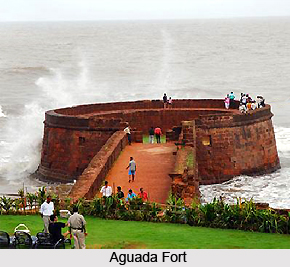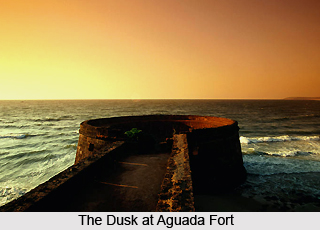 The Aguada Fort is one of the largest and most impressive forts of Goa depicting the treasured history of Goa. It was built by the Portuguese to secure their territory from the invasions of the Marathas and other mighty rulers. The fort is built on the headland that offers a wonderful site of the vast open seas.
The Aguada Fort is one of the largest and most impressive forts of Goa depicting the treasured history of Goa. It was built by the Portuguese to secure their territory from the invasions of the Marathas and other mighty rulers. The fort is built on the headland that offers a wonderful site of the vast open seas.
The Portuguese faced the most feared threat from the Europeans in the east, when a Dutch troop advanced the Mandovi in 1604. All the forts like the The Reis Magos Fort, Gaspar Dias Fort and the Cabo Fort proved to be inefficient to hold them at bay. The Dutch eventually succeeded in burning quite a number of Portuguese ships. In 1606, they moved back settling at the entrance of the river thus blocking the harbour and preventing the entry or departure of all the ships.
The Portuguese naval strength was not sufficiently strong to fight the Dutch on an open sea battle. Under the reign of the Catholic King Dom Filippe of Portugal, the construction of the fortress started with orders from the municipality levying 1 percent duty towards protection and defence of ships coming to the fort. The Fortress was finally completed in 1612.
The Aguda fort was built according to the design laid down by the Italian military architects employed by the Portuguese government. A citadel was built on the highest summit of the headland. It is linked by a defended passage to the riverside. The whole area at sea level is bordered by thick walls. The outer part of the wall has however part has now disappeared with only the relics remaining.
The citadel is now used as a jail outside the area of the fort and is visited by many tourists. The fort is in form of a square with bastions for artillery placed at each of its three corners. The fourth corner has a main gate. All the three corners are protected by a dry moat and thick walls. The fourth one faces out on the steep slope towards the river. The embrasures were extensive enough to provide a broad field of fire for the cannons. Earlier 200 cannons were a part of this fort.
The citadel gateway being narrow is blocked by heavy iron studded doors that restrict any entrance. The narrow bridge over the ditch and the sharply curved ramp leading ibto the fort makes access difficult.
One of the distinguishing features of the Aguada headlands are its Lighthouses that were built in 1864. It is one of the oldest and first lighthouses to be built in Asia. Prior to this, ships were normally guided by the bonfires that were lit on the Hill of the Pilots above the Immaculate Conception Church at Panjim. The lighthouse is kept open for the visitors who climb up the spiral staircase with a metal ladder within the lighthouse to enjoy the scenic beauty outside it.
 The architecture of the Aguda fort is splendid. The Viceroy along with the architect and engineer has been commemorated on a copper plaque in the `turret` of the tower. The great bell from the Augustinian church in Old Goa was brought in this fort before it was transferred to the Panjim Church.
The architecture of the Aguda fort is splendid. The Viceroy along with the architect and engineer has been commemorated on a copper plaque in the `turret` of the tower. The great bell from the Augustinian church in Old Goa was brought in this fort before it was transferred to the Panjim Church.
The lighthouse is bordered by places like Panjim to the east along the river. The Miramar and Caranzalem beach leads to Cabo with the Governor`s house on its point. On the western side lie the famous Baga Beach and Calangute Beach. While the Candolim church is located inland to these beaches.
A freshwater spring beneath the steps of the fort supplied water supply to the ships that stop by. Its arched caverns had the capacity to hold more than 10 million litres of water. It is for this reason that the fort was named Aguda as the word Aguda signifies water.
Fort Aguada is also famous for the small chapel dedicated to `Our Lady of Good Voyage.` It was named such as the ships after a long voyage anchored at this place before embarking upon another journey.
A part of the fort is used as a prison. There is a statue of a man and a woman at the gates of the prison. The man is seen holding a child in his arms while the woman has her arms raised in the air representing the breaking of chain bondage in front of the national emblem of India, the Ashoka Pillar. It also has an inscription that is dedicated to the memory of people, dead and alive who have laid down their precious life for the cause of freedom from the clutches of foreign powers.
Today Aguda Fort was been developed into a Beach Resort. The land around the fort is owned by The Indian Hotels Co. The five-star hotel is owned by the Tatas that overlooks the Arabian Sea located on the Sinquerim Beach. It is one the most popular tourist spots in Goa.



















